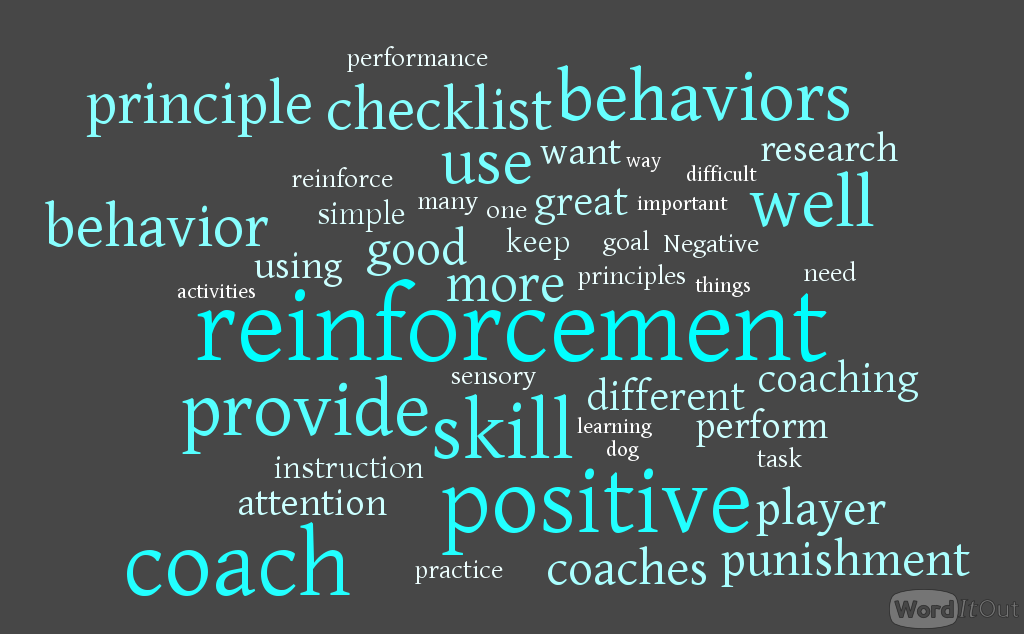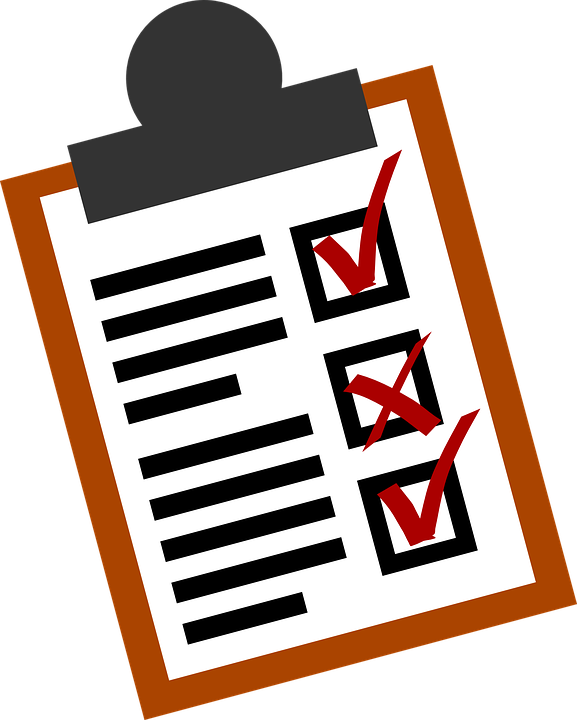Most coaches know positive reinforcement is important. But it’s more than just having a positive attitude or complimenting a job well done. These five principles are what make reinforcement work.
By Andy Driska

Being a positive coach is a great thing to strive for. Few people would disagree with that. But positive is a word that means different things to different people. And giving positive reinforcement can also mean different things to different coaches.
The effective use of positive reinforcement creates better learning and skill development situations for athletes, helps lower athlete anxiety and increase athlete confidence, and makes athletes more likely to return for the next season. And coaches that use reinforcement effectively get higher athlete satisfaction ratings compared to coaches who don’t.
The goal of this article is to reaffirm that being a “positive” coach is a good thing, but also to provide a much deeper understanding of positive reinforcement: what it is, how it works, and five important principles to consider when using it. We also provide a checklist that you can use to self-evaluate your own reinforcement behaviors.
What is Reinforcement?
Let’s start with a quick history and definition. Reinforcement comes from behaviorism, a branch of psychology that studies how animals and human beings respond to different reinforcers from their environment. The pioneering work was done by B. F. Skinner, who developed the theory of operant conditioning. This theory was developed primarily with studies of animals, but many of the principles have been adapted by the field of applied behavior analysis.

Operant conditioning follows a specific process. An athlete performs a behavior and the coach chooses how to respond to that behavior. If the goal is to increase the frequency of that behavior, the coach should provide reinforcement. Reinforcement can be positive or negative (more about the difference later). If the goal is to decrease that behavior, the response should be punishment. However, extensive research has shown the limitations and problems of using punishment (it creates a short-term fix but creates long-term distress). The goal for a coach should be to use reinforcement to increase desirable behaviors and to drastically limit the amount of punishment, ideally never using it at all.
Now, some clarifications.
- Positive reinforcement is a reward for performing the behavior correctly. It should come soon after the behavior is performed. It is usually in the form of a quick vocal praise (“nice pass”), a clap, or a supportive gesture (like a head nod or fist-pump).
- Negative reinforcement follows a correct performance, but involves removing something undesirable to reinforce the desired behavior. A simple example is taking away a difficult conditioning workout if players perform well on some behavior, like paying attention during a tactical drill, or vocally encouraging their teammates).
- Punishment happens in response to an incorrect or undesirable behavior, and involves the presentation of something unpleasant (like making the player run or do push-ups). Punishment is usually psychological, like ridicule or embarrassment, and it often trends towards abuse.
Negative reinforcement is not the same as punishment. Punishment is usually wielded in an unpredictable and irrational manner – when the coach loses control of a situation. Negative reinforcement gives players a chance to perform in a desirable way, with the consequence clearly defined. One of my favorite examples is the “get-out swim,” where a swimmer can end a grueling workout for the team if they can perform near a personal-best time standard. The goals and consequences are clear, and athletes often relish the opportunity to perform under pressure; in fact, players need to learn to perform under pressure in practice to help them when they experience pressure in game situations.
Coaches should strive to use only reinforcement – mostly the positive kind – to shape player behaviors. This was made plainly obvious to me a few months ago when I started using clicker training with my dog. It’s all about capturing good behaviors (being patient enough for my dog to perform the ideal behavior), then immediately rewarding her (click, then treat). That is classic positive reinforcement. A dog is not intelligent enough to understand negative reinforcement, and punishment just creates emotional distress.
If you want to train a dog, you have nothing but positive reinforcement at your disposal. It got me thinking, what if coaches could only use positive reinforcement?
Research has shown that coaches trained on the proper use of reinforcement can be more effective than coaches without training (psychology researchers Ron Smith and Frank Smoll have documented extensive research findings to support this idea). There are also some interesting cross-overs with motor learning research that complicate the long-established principles of behavior reinforcement. So, my goal in this article is to give you five solid principles of reinforcement that you can use as a checklist to evaluate your own practices
The 5 Principles of Using Reinforcement as Coach
Principle 1 – Planning
Clearly identify the behaviors you want to reinforce before practice starts.
At the beginning of a season, sit down and map out the types of behaviors your want to see from your players. It might be high levels of effort during practice. It might be persisting through mistakes while learning a new tactical skill or refining technique. It might be supporting teammates when they make mistakes or don’t get a good break. Write down these behaviors, then identify concrete examples of what these behaviors look like. Don’t take it for granted that everyone knows what “high effort” looks like. Does it mean arms up on defense? Clapping and chattering to keep emotions positive during difficult conditioning exercises? Be specific.
Next, share these concrete examples with the players. It helps to have a checklist of these behaviors as a reminder, so that when you see players doing them, you will be more likely to reinforce them. When starting out, keep your focus on these important behaviors, looking for opportunities to provide reinforcement. Side note: if you coach players in late-adolescence, you might want to get some of your team leaders involved in this process; this can be a good way to involve them in the process of leadership.
Planning has the effect of focusing our attention. If we don’t plan, then we’ll reinforce whatever strikes us in the moment. Of course, the downside to planning is that you’ll be less likely to notice things that aren’t on your list of ideal behaviors to reinforce. If you find this difficult, a good compromise strategy would be to set aside one practice per week to try this approach (this is an idea I got from Division 1 track and field coach J. J. Clark, currently at the University of Connecticut). Make Tuesday afternoon practices “positive Tuesdays,” where your goal is to set-up activities that players can nail, then reply with the appropriate reinforcement when you see the behaviors on your list.
Principle 2 – Contingency
Give positive reinforcement when the behavior is done well. In response to a mistake, provide encouragement or instruction.
I think this is the most challenging principle of reinforcement. You have to know what “good” looks like. You have to recognize that “good” for one athlete may not be good for another athlete, as every athlete comes with a different level of skill. You have to recognize that there is not one correct way to perform a skill, but often there are many correct ways to solve the problem.
Nonetheless, if you say “well done” when the athlete has not performed the skill very well, it’s false praise, and the odds are that the athlete will know it’s false praise. It’s tough being honest sometimes, but if you have built a supportive but challenging climate and you support your players striving to improve, then you’re in a good position to give honest feedback.
You have some options when an athlete makes a mistake or doesn’t perform ideally. You can provide encouragement to keep trying. You could encourage them to try a different solution to the problem. Try asking them instead, like, “that doesn’t seem to be working, how could you change it up?” You can also provide technical instruction. Of course, you’ll want to keep this instruction relatively short and simple, not a full-scale diagnosis of everything they are doing wrong – that would be too much feedback for the player to use.
You might also consider the use of a different teaching approach to teach the skill. In a forthcoming post, I’ll discuss the constraints-led coaching approach, a “hands-off” approach that favors changing up the task you are using to teach a skill, or using equipment, instead of providing extensive instruction. Here’s an example in soccer and another example in physical education teaching if you want to read more right now.
Principle 3 – Parsimony
Keep praise objective, simple, and short.
Simple phrases like “got it!” and “bingo!” can really go a long way. Non-verbals are also great; a simple clap after a successful skill performance says just what you need say. It’s sort of like clicker training for a dog. This might sound a little crazy, but some medical educators are actually using clickers to train medical residents on surgical skills. Check out this Hidden Brain podcast episode “When Everything Clicks” (or the transcript) for some great perspective.
If the action you are trying to reinforce is a little more complex, or if an athlete is trying to build a complex skill in parts, then it’s important to make the feedback specific. “Great knee bend” you might tell a basketball player working on a jump shot. Other parts of the skill, like their arm extension and follow through, might be coming along slowly and beg for your critique, but keep your attention and your reinforcement focused on what the player is doing well. Patience pays here. If you want the arms to extend and follow through, what about moving the player further from the basket? If the arms don’t follow through, great feedback will come from the resulting air-ball. Let the player figure it out and self-correct, instead of giving the critique.
Principle 4 – Necessity
Determine if any feedback from the coach is necessary, or if feedback could come from the task itself.
If an athlete is performing a task well, getting better, being challenged by a drill, and maintaining focus and interest, is your feedback really necessary? Do you really need to open your mouth when things are going well? Great drills, activities, and games often don’t need reinforcement from a coach because they already provide natural, sensory feedback to the players.
If you think back to some of your earlier experiences learning a skill, how influential was coach reinforcement compared to learning from your own performance? A coach’s instruction and reinforcement can help, but probably the most important thing a coach does is selecting and planning activities, drills, and games that provide great sensory feedback to the athlete performing the skill. Sensory feedback is what the brain and body can perceive from a performance without feedback that comes from a coach or outside source. That kind of feedback – augmented feedback – is often not as effective, especially for younger athletes. Your verbal feedback on performance is probably too difficult for an 11-year-old to turn into a meaningful skill correction.
To me, great activities are the ones where you don’t need to provide lots of instruction and reinforcement, where the athlete can learn in their own way, from the task itself. The role you play as a coach might be scaling-up the task and making it more difficult for a player that has achieved mastery and is starting to get bored. Here, the coach is finding the challenge point – the point where the difficulty of the task matches the skill of the player.
I’ll give an example of sensory feedback replacing augmented feedback from my swim coaching experience. Most any swim coach has spent plenty of time encouraging swimmers to streamline to the flags (15 feet) after pushing off the wall. A few swimmers do it well, but most will surface too soon, especially when they fatigue. A coach can scream and yell until blue in the face, but it’s tough to argue with fatigue. A better solution is to fasten a floating Styrofoam pool noodle to the lane-line at 15-feet, which floats like a marker buoy at the surfacing point. If the swimmer surfaces too early, they will bump the pool noodle, getting clear sensory feedback on their performance. If they streamline far enough, they won’t hit the buoy. The feedback comes immediately, through sensation and without the coach’s judgment. In my experience, it works much better than constantly barking at swimmers about surfacing too early.
Modifying equipment or activities selectively to increase sensory feedback and reduce augmented feedback are one of the best strategies to have in your coaching playbook.
Principle 5 – Distribution
Reinforcement should be distributed throughout a session and equitably among players.
Early coaching research quickly pointed out that many coaches provide more attention and feedback to players with more skill. It seemed obvious but unfair that only the best athletes were getting the coach’s attention. So, is the appropriate solution to provide extensive attention and feedback to players with lower skill levels? The best answer, as with many psychological questions, begins with the phrase “It depends.”
Although some research has shown good outcomes for coaches that distribute feedback equitably across players regardless of skill level, other research has shown that attention from coaches can be problematic for lower-skilled players. If the coach’s actions are primarily instructive and corrective, all of the coach’s attention reinforces the reality that the player is not as skilled as their teammates, creating a drop in motivation.
Many coaches provide an abundance of correction and instruction to their most skilled players because those players can use it and respond well. But over time, it might be problematic or push that athlete too far towards perfectionism. Those athletes need simple encouragement and positive reinforcement as well, not constant critique.
So, the challenge is to provide a range of reinforcement across all players. I found that many of our coaching students struggle with distribution of their feedback, so that makes for a great segue to our checklist activity.
Try the Checklist to Evaluate Your Reinforcement Behaviors
Graduate students in our sport coaching and leadership program use this reinforcement checklist to take an inventory of their reinforcement behaviors. The checklist asks you to grade yourself on each reinforcement principle, then provide an overall grade for your reinforcement strategy. You can use the checklist as a way to target improvements to your reinforcement strategy. It’s also a great activity for an entire coaching staff to complete; it can be a conversation starter for a mentor meeting, or it can be the topic for a staff training.

Please give attribution if you reuse or re-purpose this checklist.
For most people, our perceptions of our actual behaviors skew positively. We think we follow all of these principles quite well. But how well do your perceptions line-up with reality? Ask a colleague to complete the same checklist for you, and see how well your scores line-up. If you want to be more adventurous, have a colleague or parent videotape you at practice. If you have never seen a video of yourself coaching, it is probably one of the most insightful learning experiences you will ever have as a coach.
Take-Home Points
- To use positive reinforcement effectively, you must plan in advance (principle 1), then be deliberate and contingent in how you give it (principle 2).
- Negative reinforcement and punishment are two different things. Positive reinforcement should be used as the primary tool, and punishment should ideally not be used at all.
- Keep positive reinforcement short, objective, and simple (principle 3).
- Reinforcement isn’t always necessary. Often, a well-designed or modified activity, or a strategic use of equipment, can be more effective than feedback from a coach (principle 4).
- Be mindful of how your feedback is distributed across your players and throughout the duration of a practice session (principle 5).
- Evaluate yourself using the Reinforcement Checklist, and challenge yourself to be evaluated by a peer or by video.

Andy Driska is an Assistant Professor in the Department of Kinesiology at Michigan State. He coordinates the graduate programs in sport coaching and leadership and teaches courses in sport psychology, skill acquisition, and coaching science. He conducts research on coach education and athlete development. He is affiliated with the Institute for the Study of Youth Sports.




